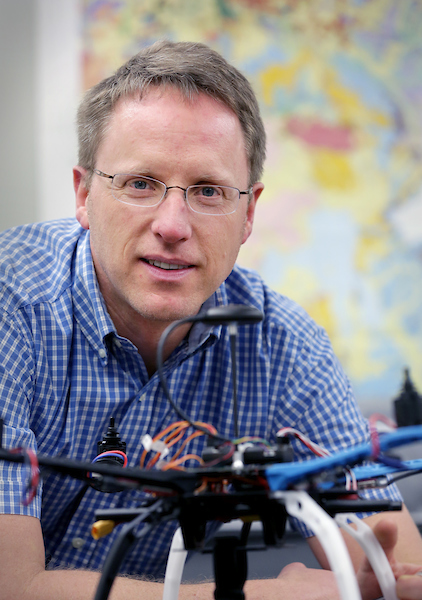Green Energy: What’s the best option?

UW-Whitewater/ Craig Schreiner
UW-Whitewater Professor of Geography, Geology & Environmental Science Eric Compas
April 24, 2022
What’s the “greenest” form of energy? If you’re trying to be more sustainable, you’re likely trying to decide what energy source to buy into or support. That question has two answers; one is simple, and one is more complicated.
Let’s start with the simple answer. The greenest form of energy is the energy that we don’t use – through efficiencies and behavior changes that reduce direct energy usage (like not driving your car as much) or that reduce indirect energy usage (like repurposing clothes or furniture). Americans, in general, have 2.5 times the carbon footprint of Europeans for a similar quality of life. All of us can make substantial changes to decrease our energy usage: driving less, carpooling more, reducing our heating and cooling needs, and walking and biking more. Using less energy is the greenest thing we can do.
And the complicated answer? It depends on how you define “green.” If you just look at carbon emissions and the total “life cycle” of that energy from creation to disposal, wind energy has the lowest carbon footprint in the locations where it’s the most efficient. But turbines tend to be further from population centers where energy is needed and some energy needs to be stored in batteries with significant environmental impacts. So geography matters: we lose around 5% of our electricity through transmission, and having a not-so-green power source nearby can be better than something greener further away. For example, hydropower if it’s nearby, would be better than wind that has to be transported from a long distance.
So what about Wisconsin? An analysis by the National Renewable Energy Laboratory, part of the US Department of Energy, found that wind (particularly off-shore) and solar (particularly smaller, distributed systems) were the best options for Wisconsin. The state recently approved the largest solar array in Wisconsin, the Koshkonong Solar Energy Center, that will generate 300 megawatts of electricity in Dane County. And more solar arrays are in the proposal stage.
Write your legislators and power company asking for more projects like these if you want greener energy options for Whitewater and Wisconsin.













Tara J Vasby • Apr 26, 2022 at 3:02 pm
As a 1995 graduate of UWW – I have to respectfully disagree with your assertion about the Koshkonong Solar facility. You, and the PSC, seem to not care a whit about the long term future of rural Wisconsin. As an intervenor in the case against Invenergy and Koshkonong – we showed time and again that the environment and the agriculture use of the land will NEVER return. Supporting these projects is simply supporting the destruction of the environment in an effort to make those living in urban centers feel better (and pay much much more for it) about where their energy comes from.
The 25 acres of battery storage will only hold FOUR HOURS worth of power. Is that worth it being a half mile from our Elementary school, a new subdivision – and the very real risk of a thermal runaway event that will impact the entire community of Cambridge for days and weeks?
I guess you think so.
https://www.wiscnews.com/opinion/column/tara-vasby-neighbors-arent-nimbys-for-opposing-solar-plant-near-cambridge/article_43c64364-313d-5b4c-b38c-0d79b887fa28.html